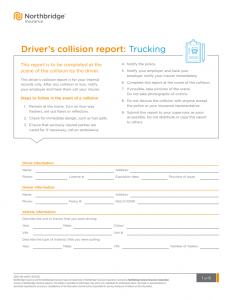You’re a safe driver, but you can’t control road conditions or how other vehicles behave while driving. Every carrier and transportation company is responsible for keeping their vehicles in good working condition, and their drivers well-trained, but crashes can (and do) still happen. In fact, one in five road crashes in Canada involve large commercial vehicles, and while a truck driver may walk away unharmed, the outcome for the drivers and passengers in the other vehicles can often be more serious.
Many factors could lead to a truck collision or rollover, but a few specific measures will help drivers respond more effectively in the wake of an incident. Learn more about the common causes of commercial vehicle collisions, along with tips on how best to handle the immediate aftermath of a collision. You can also download our driver’s collision report form – which you can keep in your vehicle to help stay organized and in control if a collision occurs.
What are the main causes of collisions involving commercial vehicles?
Not all collisions can be traced to one glaring error or a major malfunction. In many cases, a moment of miscommunication or an unexpected event can force a reaction which results in a collision. However, there are a couple of causes which can be avoided by taking the appropriate steps:
Unsafe driving habits like speeding and tailgating
In 2023, collisions involving transport trucks reached a 10-year high in Ontario. Speeding or driving too fast accounted for one in four of these collisions.
The Ontario Provincial Police cited that speeding, following too closely, and improper lane changes were the primary causes in collisions involving large commercial vehicles.
Distracted driving
In Canada, distracted driving contributed to almost one in five fatal collisions recorded in 2022. Transport Canada advises it’s incredibly important to include driver distraction mitigation training in your onboarding of new drivers and continue this training for all employed drivers. You can find additional resources and training materials through the Transport Canada website.
Experts often acknowledge that not all truck drivers pose a safety risk (many can be some of the safest drivers out there!) but since heavy vehicles often carry a greater potential for harm, truck drivers also have a greater responsibility when behind the wheel. Distracted driving and inattention have the potential to be deadly on the road.
In 2023, 399 collisions involved large commercial vehicles.
What to do if you’re involved in a collision?
Collisions are traumatic, and the aftermath can often be overwhelming. Without a clear head and a calm demeanor, you may forget some key details that could complicate things in the days following a collision. Here are some tips on what info to record and what steps to take::
Don’t make things worse
First and foremost, remain at the scene of the collision. Next, take some steps to make the scene a bit safer for everyone, like setting out flares or reflectors, checking for fuel spills, and ensuring any injured parties are identified to emergency responders. Following a collision it’s important to try and prevent more from occurring until help arrives.
Communicate wisely
While you probably don’t want to chat openly and continually with everyone at the scene, there are a few people to speak with right away. First, notify your local police, and if anyone is injured, call for an ambulance. Once help is on the way, notify your employer and have them call your insurance company. Aside from the police and your insurance representative, avoid discussing details of the collision with anyone.
Fill out a collision report as soon as possible
It’s much easier to gather crucial info right after the incident occurs, so complete your collision report at the scene. You can also have anyone who witnessed the collision give you their contact details for you to include in your collision report, and then you can take some photos of the scene (but be mindful to not include photos of any victims).
Ensure your commercial vehicles are protected with the right business insurance
Dealing with a collision is never easy, but it can be more manageable when you have a good risk mitigation plan. Even if you take all the right steps, unforeseen collisions and incidents can still happen. This is where the right business insurance can help. If you want to learn more about business coverage that can help your business, visit our transportation insurance page.





